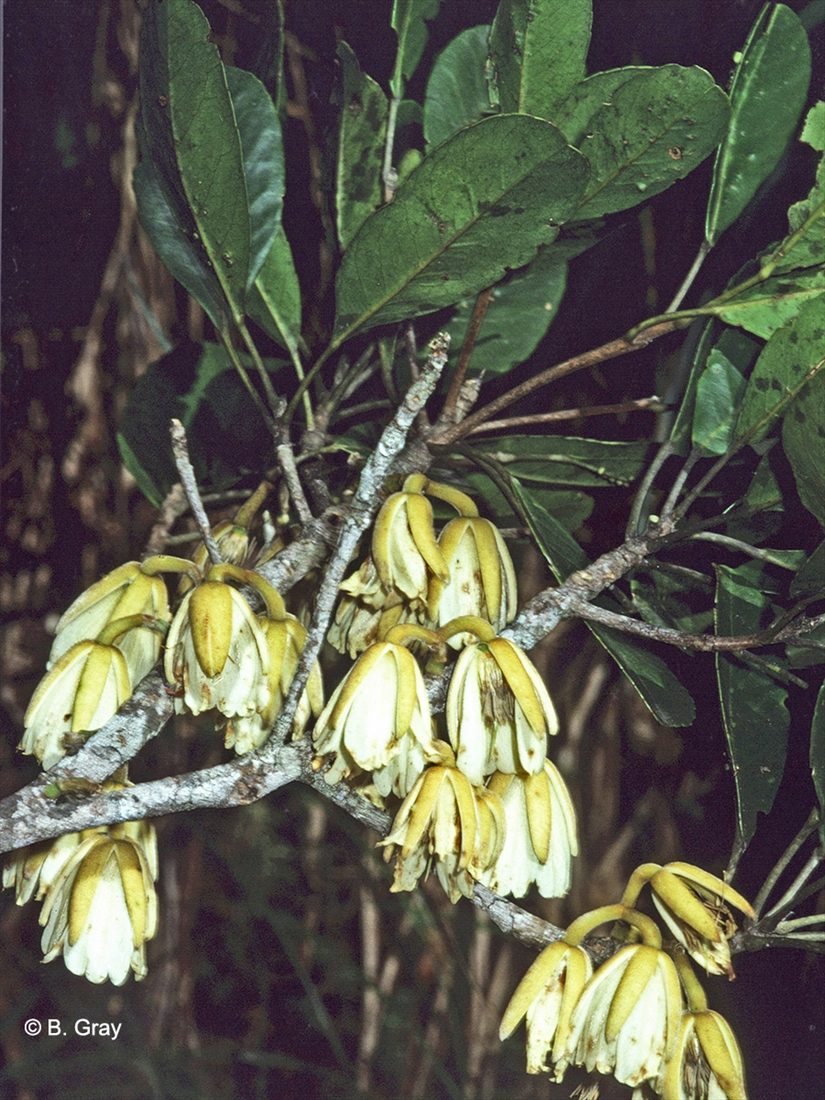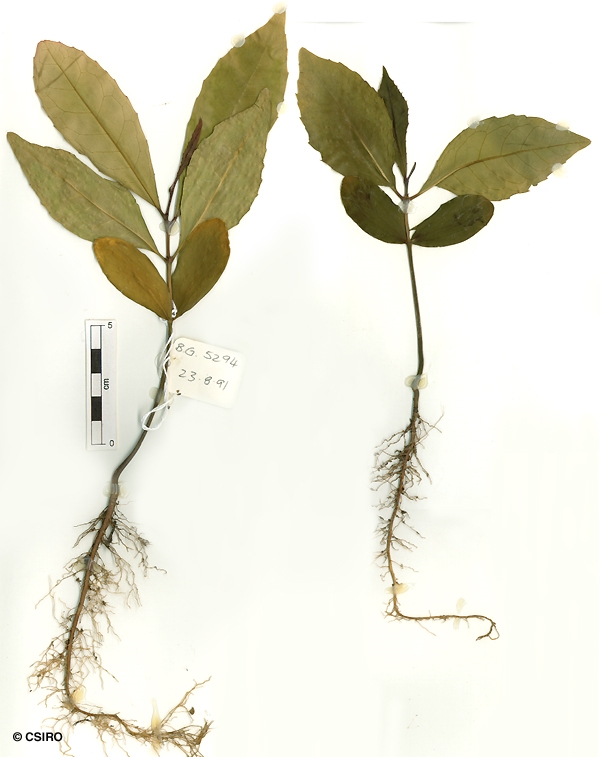Australian Tropical Rainforest Plants - Online edition
Elaeocarpus carbinensis J.N.Gagul & Crayn






Gagul, J.N. & Crayn, D.M. (2018) Austrobaileya 10(2): 249-254. Type: Queensland. Cook District. SFR 143, Kanawarra, Carbine LA, 25 January 1995, B. Gray 5938 (holo: CNS [2 sheets]; iso: B, BO, BRI, CANB, E, K, L, MEL, MO, NY, NSW, SING distribuendi).
Quandong
Leaves simple, alternate, crowded toward the branchlet tips; petiole (15–)20–45(–58) mm long, ± glabrous, usually with pulvinus at both ends, more pronounced at distal end; lamina thick and leathery, obovate, oblanceolate or elliptic, 45–180 mm long, 19–80 mm wide, abaxial surface punctate, densely covered with small dark dots (? glands) visible (barely) to the naked eye, base cuneate, apex obtuse or slightly retuse; domatia present in secondary vein axils, 2–8(–10) per leaf, foveolate, glabrous; margins entire or crenate, about 15-20 inconspicuous teeth on each side of the leaf blade; venation reticulate, ± flush with adaxial leaf surface when fresh (slightly raised in dried material), prominent abaxially, ± glabrous; lateral veins forming loops well inside the blade margin. Old leaves turn red prior to falling.
Inflorescences 2–5-flowered, usually arising behind leaves, occasionally axillary, racemose but appearing ± umbellate; peduncle 12–15 mm long, pubescent, hairs <0.5 mm, appressed. Flowers white or cream; pedicels 10–18 mm long, pubescent, hairs 0.5–1 mm, spreading; calyx cream or greenish cream to brown, lobes narrowly triangular, 24–26(-30) mm long, 5–6 mm wide at base, apex acute, densely pubescent to velvety outside, hairs 0.5–1 mm long, spreading to erect, goldenbrown when dried, sericeous inside, hairs 2–3 mm long, appressed; petals 5, free, 35–40 mm long, c. 10 (-15-20) mm wide, apex 2–3 lobed, lobes c. 5 mm long, rounded to acuminate or acute, with dense hairs on the outside, glabrous or with very few scattered hairs on the inside, indumentum extending across middle half, and along 3/4 of the length of the petal, hairs appressed, 2–3 mm long, margins entire, glabrous; ovary hairy, globular, 5-locular, c. 10 ovules per locule, sericeous, hairs c. 2 mm long, erect to appressed; style 18–22 mm long, tapering to ovary, sericeous over the lower 2/3, hairs similar to ovary, stigma not expanded; stamens numerous (40-50(-55)), filaments very slender, 10–15 mm long, sericeous, anthers tubular, c. 8 mm long, with very short ascending hairs, longer (to c. 1 mm) along midline on back, awned, posterior tooth longer (c. 1.5 mm), backward-tilted.
Fruits drupaceous, broadly ovoid to ellipsoid, 50–55 mm long, 35–50 mm wide, dark blue, or slatey to brownish grey, glabrous, shrinking and cracking irregularly upon drying; pedicel 15–25 mm long; outer mesocarp 1.7–2.2 mm thick, detaching cleanly from inner mesocarp (stone). Mesocarps ovoid-ellipsoid, 30–45 mm long, 32–40 mm wide, robust, woody; sutures 5, forming grooves on prominent longitudinal ridges (flanges), grooves becoming shallower basally; flanges 3–4 mm high, 3–5 mm thick (mesocarp appearing 5-angled in transverse section, wall c. 11 mm thick), base attenuate, apex rounded to slightly pointed; surface punctate. Seeds 1–3 per fruit, ellipsoid, 18–20 mm long, 8–10 mm wide; embryo straight, endosperm entire.
Cotyledons elliptic, about 40-50 x 15-20 mm. At the tenth leaf stage: leaf blade +/- elliptic, apex bluntly acuminate; margin crenate, teeth inconspicuous with a fine aristate tip, glabrous; stipules small, triangular, caducous. Seed germination time 76 days.
Endemic to NEQ, an uncommon tree restricted to the Carbine Tableland west of Mossman and found only in the Mt Lewis-Mt Spurgeon-Mt Misery area. Altitudinal range from 940-1260 m. Grows in well developed mountain rain forest (notophyll vine forest and mixed mesophyll vine forest) on soils derived from granite.





